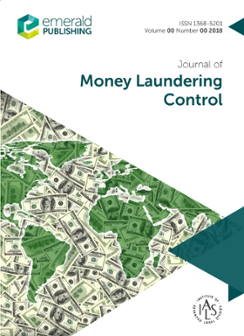Table of contents
Interaction effects of professional commitment, customer risk, independent pressure and money laundering risk judgment among bank analysts
Zuraidah Mohd-Sanusi, Yusarina Mat-Isa, Ahmad Haziq Ahmad-Bakhtiar, Yusri Huzaimi Mat-Jusoh, Tarjo TarjoThis study aims to examine the direct and indirect effects of professional commitment, customer risk and independence pressure on money laundering risk judgment among bank…
Administrative model of financial intelligence units: an analysis of effectiveness of the AML/CFT regime
Sisira Dharmasri JayasekaraThe purpose of this paper is to study the impact of the model of an financial intelligence unit (FIU) and the availability of resources of an FIU on the strength of the anti-money…
Re-examining corruption and economic growth nexus in oil dependent economy: Nigeria’s case
Mathew Ekundayo Rotimi, Ojo Joseph IseOlorunkanmi, Gift Grace Rotimi, Mishelle DoorasamyThe purpose of this study is to empirically examine how corruption impacts economic output growth in Nigeria. This is because of the recent trend in the level of corruption.
A new criminal jurisdiction to combat cross-border money laundering
Hanafi Amrani, Mahrus AliThe purpose of this study is to analyze the emergence of the changing face of criminal jurisdiction in dealing with cross-border money laundering that develops dynamically due to…
Data quality issues leading to sub optimal machine learning for money laundering models
Abhishek Gupta, Dwijendra Nath Dwivedi, Jigar Shah, Ashish JainGood quality input data is critical to developing a robust machine learning model for identifying possible money laundering transactions. McKinsey, during one of the conferences…
Anti-money laundering obligations and dismissal of bankers: evidence from Malaysia
Aspalella A. Rahman, Harlida Abdul WahabThis paper aims to analyse the anti-money laundering (AML) obligations imposed on bankers as the main reporting entities under the AML regime in Malaysia. Apart from discussing…
An expectation-performance gap between money laundering reporting officers and their directors – evidence from Germany
Lars HaffkeMoney Laundering Reporting Officers (MLROs) carry out day-to-day anti-money laundering (AML) tasks while directors ultimately remain responsible for AML compliance. Therefore…
On the potential of a graph attention network in money laundering detection
Guang-Yih Sheu, Chang-Yu LiIn a classroom, a support vector machines model with a linear kernel, a neural network and the k-nearest neighbors algorithm failed to detect simulated money laundering accounts…
Money laundering, food activities and mafia: evidences from the Italian provinces
Maria OlivaAccording to the INTERPOL definition, money laundering is: “any act or attempted act to conceal or disguise the identity of illegally obtained proceeds so that they appear to have…
Demand for money laundering in developing countries and its deterrence: a quantitative analysis
Anam Javaid, Noman ArshedMoney laundering is an activity where illegal proceeds are hidden. This often leads to a reduction in government revenue and loss of government control of public funds. This study…
International commercial arbitrator addressing money laundering sua sponte
Todor KolarovThe purpose of this paper is to evaluate the existing legal basis, and its practical application, of an arbitrator’s competence to raise on her own initiative money laundering…
Cash economy, criminality and cash regulation in Ethiopia
Messay Asgedom Gobena, Daniel Gebreegziabher KebedeThis paper aims to examine the contribution of Ethiopia’s cash economy to financial crimes. It also investigates the regulation of cash in the context of controlling crime…
Anti-money laundering regimes: a comparison between Germany, Switzerland and the UK with a focus on the crypto business
Christoph WronkaThis paper aims to examine the framework for the regulation of crypto assets in Germany, the UK and Switzerland focusing on anti-money laundering (AML) laws. It comprehensively…
Financial institutions and anti-money laundering violations: who is to bear the burden of liability?
Muhammad Saleem Korejo, Ramalinggam Rajamanickam, Muhamad Helmi Md. SaidMoney laundering (ML) is one of the greatest challenges, the global community faces today. Corporate entities such as financial institutions (FIs) are most susceptible to…
The preferred type of financial intelligence for early detection of terrorist financing activities
Hussain Syed GowhorThis paper aims to inform the readers about the preferred type of financial intelligence for early detection of terrorist financing activities.
The anti-money laundering framework for precious stones and metals dealers in Singapore
Vincent OoiPrecious stones and metals have commonly been used throughout the world as a conduit for terrorism and money laundering activities. Such illicit use of these assets has called for…
Analysis of the activities of law enforcement authorities in the field of combating crime and corruption offences
Oleh M. Omelchuk, Ihor Yo. Haiur, Olena G. Kozytska, Anna V. Prysiazhna, Natalia V. KhmelevskaThe purpose of this study is to analyse the activities of law enforcement bodies in the field of combating crime and corruption offences.

ISSN:
1368-5201Online date, start – end:
1997Copyright Holder:
Emerald Publishing LimitedOpen Access:
hybridEditors:
- Dr Li Hong Xing
- Prof Barry Rider